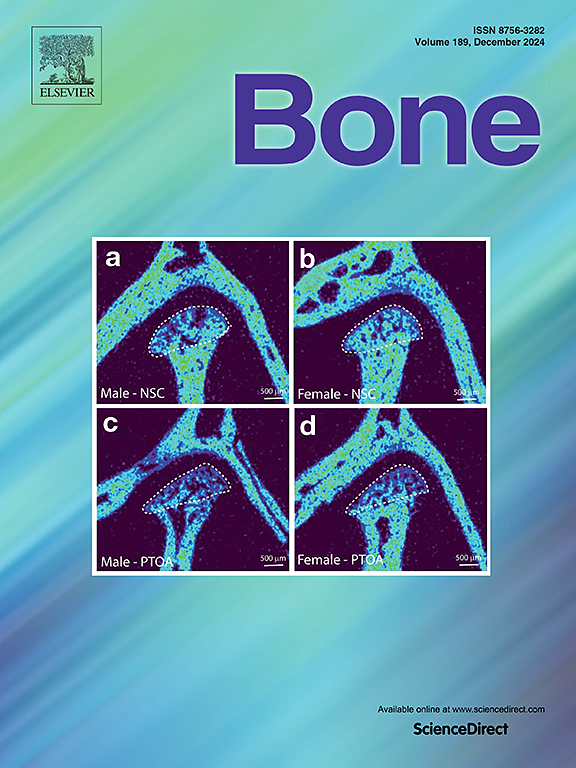Gastrointestinal complaints in patients with osteogenesis imperfecta: The bright side of a rare genetic disorder
IF 3.5
2区 医学
Q2 ENDOCRINOLOGY & METABOLISM
引用次数: 0
Abstract
Background
Osteogenesis imperfecta (OI) is a rare hereditary disorder of connective tissue. A Danish national registry study surprisingly identified digestive causes as one of the leading causes of OI mortality. However, there is a dearth of prospective data describing gastrointestinal symptoms in OI. Our aim was to assess common gastrointestinal symptoms in an OI patient population and compare it to the general U.S. population.
Methods
OI patients enrolled in a natural history protocol (NCT03575221) were prospectively evaluated for gastrointestinal symptoms and provided with PROMIS questionnaires for six gastrointestinal symptoms. The HMSS application was used to obtain T scores, score of 50 (and standard deviation of 10) representing the average of the general U.S. population.
Results
41 OI patients were included. Median age 28 years (IQR 18–26), median BMI 28 kg/m2 (IQR 21–34), and 54 % female. OI type IV 61 %, OI type III 20 %, and remaining patients had OI type VI, VII, XIV. The mean T score for the six gastrointestinal symptoms ranged from 46 to 49, within 1 SD from the general U.S. population. Subgroup analyses showed no differences based on age, mobility, BMI, type of OI and genetic mutations (COL1A1 vs COL1A2), except increased abdominal pain with age. Patients with severe scoliosis (>50°) reported increased nausea and vomiting, and diarrhea compared to patients with mild to moderate scoliosis.
Discussion
We report the largest cohort of OI patients evaluated prospectively and directly for gastrointestinal complaints. Study patients, which excluded type I OI, did not report gastrointestinal symptoms higher than the general population except for abdominal pain in older patients. OI patients should be carefully evaluated in the same way as any other patient presenting with gastrointestinal complaints.
成骨不全患者的胃肠道疾病:一种罕见遗传疾病的光明面。
背景:成骨不全症是一种罕见的结缔组织遗传性疾病。丹麦的一项国家登记研究令人惊讶地发现,消化系统疾病是导致成骨不全症死亡的主要原因之一。然而,缺乏描述成骨不全患者胃肠道症状的前瞻性数据。我们的目的是评估成骨不全患者群体中常见的胃肠道症状,并将其与美国普通人群进行比较:方法:纳入自然病史方案(NCT03575221)的成骨不全患者的胃肠道症状进行前瞻性评估,并提供有关六种胃肠道症状的PROMIS问卷。使用HMSS应用程序获得T评分,得分为50(标准差为10),代表一般美国人群的平均值。结果:纳入41例成骨不全患者。中位年龄28 岁(IQR 18-26),中位BMI 28 kg/m2 (IQR 21-34),女性54 %。IV型成骨不全61 %,III型成骨不全20 %,其余患者为VI、VII、XIV型成骨不全。6种胃肠道症状的平均T评分范围为46 - 49,与美国一般人群相差1个标准差:亚组分析显示,年龄、活动度、BMI、成骨不全类型和基因突变(COL1A1 vs COL1A2)没有差异,除了腹痛随年龄增加。与轻度至中度脊柱侧凸患者相比,重度脊柱侧凸(bbb50°)患者报告恶心、呕吐和腹泻增加。讨论:我们报告了对成骨不全患者进行前瞻性和直接胃肠道疾病评估的最大队列。排除I型成骨不全的研究患者,除老年患者腹痛外,胃肠道症状没有高于一般人群。成骨不全患者应像其他有胃肠道疾病的患者一样仔细评估。
本文章由计算机程序翻译,如有差异,请以英文原文为准。
求助全文
约1分钟内获得全文
求助全文
来源期刊

Bone
医学-内分泌学与代谢
CiteScore
8.90
自引率
4.90%
发文量
264
审稿时长
30 days
期刊介绍:
BONE is an interdisciplinary forum for the rapid publication of original articles and reviews on basic, translational, and clinical aspects of bone and mineral metabolism. The Journal also encourages submissions related to interactions of bone with other organ systems, including cartilage, endocrine, muscle, fat, neural, vascular, gastrointestinal, hematopoietic, and immune systems. Particular attention is placed on the application of experimental studies to clinical practice.
 求助内容:
求助内容: 应助结果提醒方式:
应助结果提醒方式:


